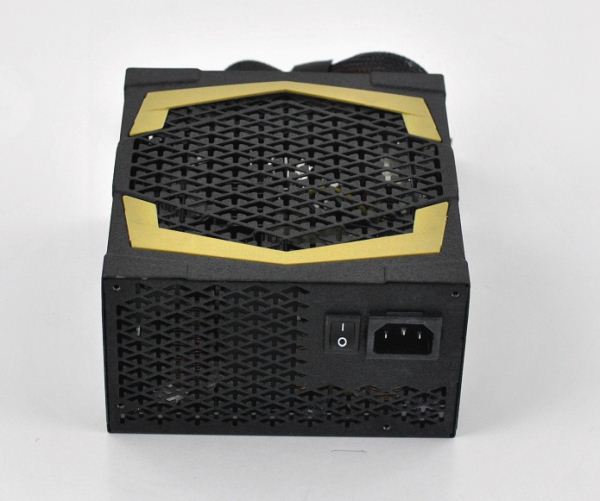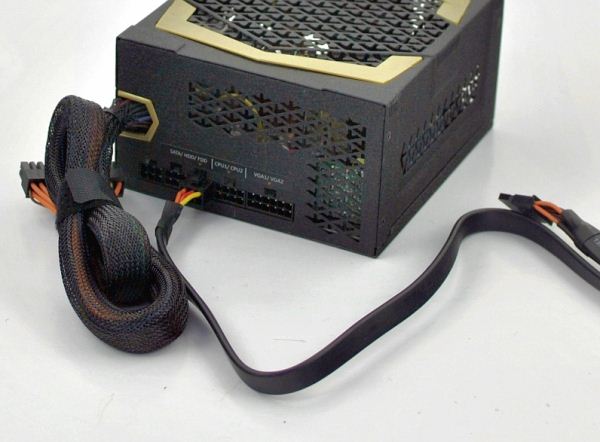FSP Aurum Xilenser AU-500FL 500W
by Martin Kaffei on April 20, 2012 4:45 AM ESTExternal Impressions, Cables and Connectors
As mentioned before FSP uses arrow-shaped ventilation holes on all sides. The AU-500FL has a connection panel for modular cables and a description for every plug-type. The rugged and very thick material is strongly reminiscent of some Enermax power supplies. It's too bad that these two golden-colored parts on the top are made out of cheap plastic.
| Cables and Connectors | ||
|
Connector type (length) |
Main | 1x 24-pin (55cm) fixed |
| ATX12V/EPS12V | 1x 4+4-pin (60cm) modular | |
| PCIe |
2x 6/8-pin (55, 65cm) modular 2x 6/8-pin (55, 65cm) modular |
|
| Peripheral | 3x SATA (ca. 55, 70, 85cm) modular | |
|
2x Molex, 1x SATA (ca. 55, 70, 85 cm) modular 2x Molex, 1x SATA (ca. 55, 70, 85 cm) modular 1x FDD adapter (ca. 15cm) modular |
||
Except the main cables with 24 pins all harnesses are removable. The 4+4 pin ATX12V, the 6/8-pin, as well as the peripheral cables are longer than 60cm, which is awesome for anyone with a larger computer case. The first peripheral cable offers three SATA connectors from 55cm to 85cm in 15cm steps. Another harness provides two HDD and one SATA connectors from 55cm to 85cm. The 24-pin motherboard connector is 55cm, which is also nice. The PCIe plug sockets have the same color like the ones for the peripheral components.


















41 Comments
View All Comments
SetiroN - Friday, April 20, 2012 - link
I have always failed to see any purpose in going completely fanless.Electronics and make more noise than a large fan at 300rpm (if not more, actually), which is inaudible; yet the difference it provides in cooling performance is pretty noticeable.
Fanless PSUs/heatsinks are just a gimmick.
Iketh - Friday, April 20, 2012 - link
I see it as the opposite. My seasonic 460w fanless simply doesn't need a fan. That's why it doesn't have one. Why throw a fan on it? Only reason for a fan for this power supply is to mount it on its side or upside down, but if you're mounting it right side up, a fan only increases power consumption and introduces dust.Even though a fan would keep the components cooler and thus reduce resistance, there is no heat generated anyhow. I've loaded this thing to 300w and still couldn't feel heat radiating from within.
TrackSmart - Friday, April 20, 2012 - link
True, but I can still see SetireN's point. The powersuppy itself will generate heat inside your computer case. Having a low-rpm exhaust fan would decrease that heat build-up, be virtually silent, and might allow the other fans inside your case to run at lower rpms. I'm guessing the powersupply might last longer, too, as it would probably stay cooler under load.Just my 2 cents.
TrackSmart - Friday, April 20, 2012 - link
It would be interesting if Martin could take a 'quiet' computer case (e.g. Antec Sonata or similar) and test to see how a fanless powersupply alters case temperatures and noise levels from other components in the system (e.g. GPU and CPU). Does having a fanless powersupply really lead to a quieter system overall, assuming that other components still have active cooling?dtolios - Saturday, April 21, 2012 - link
The amount of energy consumption simple electric devices like fans and pumps introduce to cooling systems is so minimal in comparison to the material savings for similar efficiency, or the efficiency is so much higher, that semi-active systems (like most coolers other than don't evolve around phase change, compressors and peltiers) are very easy to value engineer in favor of.Are fans and pumps the only way? Certainly not.
I would bet money tho that the same quality of components in this PSU would produce a way better overall output with the addition of a low-speed, 100% in-audible fun. We are talking 10s of times the energy "penalty" for the fun itself.
MrSpadge - Friday, April 20, 2012 - link
It's OK for people who want it really silent. However, putting a large, low rpm fan ito an efficient PSU generates almost negligible noise as well.. and is usually cheaper. It's also smart to turn that fan off completely at low and/or idle load, since there wouldn't be much heat to vent from the case anyway.kmmatney - Friday, April 20, 2012 - link
I agree - it's always nice to have a silent fan that can provide a bit of cooling, just in case.What I do wish is that someone made a PSU where you can easily get to the fan, and either replace, lube it, or change the speed. I like to lubricate the PSU fans every few years (and sometimes solder in a new fan) its a pain. When I replace the PSU fan, I usually use a fan with a variable control speed, so I can control the noise.
earthrace57 - Friday, April 20, 2012 - link
I'm running an AX 750 with an i5 2500K @ 4.0 GHz and a GTX 560 Ti, and the fan barely ever turns on, even with prime95 and furmark running. Even when it does, it barely spins (so slow that I'm sort of curious if the air it is moving actually makes a difference). So IMHO, I think if you want a "silent" PSU, get an overpowered high-end PSU.mtoma - Saturday, April 21, 2012 - link
I disagree: except for diminishing the cost in a PSU, the fan is useless. I ask all of you: do you even own a fanless PSU, since you say it's not necessary? Apart from IKeth (the second post), none of you seem to own a fanless PSU, so I bet you don't have a first hand experience with then. I also own a Seasonic 460W fanless, and today, after more than a year, it still impress me. No heat detectable, no electronic noise. Just a higher cost, which for some, is not that important. Seasonic's fanless models aren't perfect, to be sure (I wished I had 4 SATA connections per SATA cable, not 2 and 3, I wished they stop offering PATA connections, and to keep just one 6 pin connections), but they are pretty close to perfection.TrackSmart - Saturday, April 21, 2012 - link
That's exactly it. Folks are wondering if such a unit is worth the cost (versus a traditional, quiet PSU) and whether the airflow provided by a virtually-silent fan would provide superior cooling under high loads. And what effect does the heat generated by the PSU, which doesn't have an exhaust fan, have on total system temperatures. For the sake of debate, that fan could be designed to only spin-up under loads where the PSU would generate a significant amount of heat. These are questions that techies want to know before plunking down extra cash for a fanless power supply.I'm glad to hear that your Seasonic is serving you well - and I appreciate hearing about your experiences, but a more controlled test would still be interesting to see if the value proposition holds up.